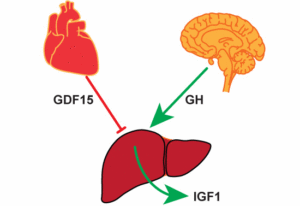
Coordinating growth with heart health ensures that the heart can keep up with the demands placed on it by the body. A recent study (1) identified a molecule called growth differentiation factor 15 [GDF15, also known as macrophage inhibitory cytokine 1 (MIC1)] that was released from the heart that signals to the liver to inhibit the release of insulin-like growth hormone (IGF1) (Figure 1). This signaling system ensures that body size is matched to heart function. GDF15 is a secreted protein that is part of the transforming growth factor β family of cytokines. IGF1 is a liver-derived peptide that stimulates growth. GDF15 is not the only signaling molecule released by cells of the heart. The heart releases many signaling molecules, collectively referred to as cardiokines (2), especially when stressed or injured.
GDF15 is not only produced by the heart and does not only regulate the release of IGF1 from the liver. Fat cells, adipocytes, also produce GDF15 in response to cytokines released by a specific type of T cell (Th2 cells) (3). Furthermore, GDF15 also functions as an autocrine regulator of heart muscle cells (4) and as a survival factor for neurons (5). The amount of GDF15 in circulation increases in people that have an injury, inflammatory disease, cardiovascular disease, diabetes, cognitive impairment, or cancer. Thus, the biology of GDF15 is complex.
Pharmacological interest in GDF15 stems from its ability to limit weight gain and improve glucose handling in animal studies. Conditions that cause increased GDF15, such as advanced cancer in humans, results in pathological weight loss and appetite suppression. In rodents, increasing GDF15 limits weight gain by decreasing food intake and improves glucose handling in animals fed a high-fat diet. Both effects suggest that manipulating GDF15 signaling may be useful in treating obesity and type 2 diabetes (Figure 2). A trio of papers report the identification of the receptor responsible for the metabolic effects of GDF15 (6, 7, 8).

The discovery of glial cell-derived neurotrophic factor (GDNF) family receptor α-like (GFRAL) as the receptor necessary for the metabolic effects of GDF15 (6,7,8) provides a key piece to solving the puzzle of the context-specific effects of GDF15. GFRAL was present in the areas of the brain involved in mediating the metabolic effects of GDF15. GFRAL functioned in a complex with the receptor tyrosine kinase RET. Both RET and GFRAL are single transmembrane proteins. GFRAL is the ligand-binding part of the complex; RET is the signal-mediating part of the complex. Whether this same receptor complex mediates the other functions of GDF15 remains to be determined.
Highlighted Articles
- Wang, T., Liu, J., McDonald, C., Lupino, K., Zhai, X., Wilkins, B.J., Hakonarson, H., Pei, L., GDF15 is a heart‐derived hormone that regulates body growth. EMBO Mol. Med. 9, 1150–1164 (2017). PubMed
- Dewey, C.M., Spitler, K.M., Ponce, J.M., Hall, D.D., Grueter, C.E., Cardiac‐secreted factors as peripheral metabolic regulators and potential disease biomarkers. J. Am. Heart Assoc. 5, e003101 (2016). PubMed
- Lee, S.E., Kang, S.G., Choi, M.J., Jung, S., Ryu, M.J., Chung, H.K., Chang, J.Y., Kim, Y.K., Lee, J.H., Kim, K.S., Kim, H.J., Lee H.K., Yi, H.S., Shong, M., Growth differentiation factor 15 mediates systemic glucose regulatory action of T helper type 2 cytokines. Diabetes DOI:10.2337/db17-0333 (2017). PubMed
- Xu, J., Kimball, T.R., Lorenz, J.N., Brown, D.A., Bauskin, A.R., Klevitsky, R., Hewett, T.E., Breit, S.N., Molkentin, J.D., GDF15/MIC-1 functions as a protective and antihypertrophic factor released from the myocardium in association with SMAD protein activation. Circ. Res. 98, 342-350 (2006). PubMed
- Machado, V., Haas, S.J.-P., von Bohlen und Halbach, O., Wree, A., Krieglstein, K., Unsicker, K., and Spittau, B., Growth/differentiation factor-15 deficiency compromises dopaminergic neuron survival and microglial response in the 6-hydroxydopamine mouse model of Parkinson’s disease. Neurobiol. Dis. 88, 1–15 (2016). PubMed
- Yang, L., Chang, C.-C., Sun, Z., Madsen, D., Zhu, H., Padkjær, S.B., Wu, X., Huang, T., Hultman, K., Paulsen, S.J., Wang, J., Bugge, A., Frantzen, J.B., Nørgaard, P., Jeppesen, J.F., Yang, Z., Secher, A., Chen, H., Li, X., John, L.M., Shan, B., He, Z., Gao, X., Su, J., Hansen, K.T., Yang, W., Jørgensen, S.B., GFRAL is the receptor for GDF15 and is required for the anti-obesity effects of the ligand. Nat. Med. DOI: 10.1038/nm.4394 (2017). PubMed
- Emmerson, P.J., Wang, F., Du, Y., Liu, Q., Pickard, R.T., Gonciarz, M.D., Coskun, T., Hamang, M.J., Sindelar, D.K., Ballman, K.K., Foltz, L.A., Muppidi, A., Alsina-Fernandez, J. Barnard, G.C., Tang, J.X., Liu, X., Mao, X., Siegel, R., Sloan, J.H., Mitchell, P.G., ZHang, B.B., Gimeno, R.E., Shan, B., Wu, X., The metabolic effects of GDF15 are mediated by the orphan receptor GFRAL. Nat. Med. DOI: 10.1038/nm.4393 (2017). PubMed
- Mullican, S.E., Lin-Schmidt, X., Chin, C.-N., Chavez, J.A., Furman, J.L., Armstrong, A.A., Beck, S.C., South, V.J., Dinh, T.Q., Cash-Mason, T.D., Cavanaugh, C.R., Nelson, S., Huang, C., Hunter, M.J., Rangwala, S.M., GFRAL is the receptor for GDF15 and the ligand promotes weight loss in mice and nonhuman primates. Nat. Med. DOI: 10.1038/nm.4392 (2017). PubMed
- Jiang, J., Wen, W., Sachdev, P.S., Macrophage inhibitory cytokine-1/growth differentiation factor 15 as a marker of cognitive ageing and dementia. Curr. Opin. Psychiatry 29, 181–186 (2016). PubMed
- Yao, X., Wang, D., Zhang, L., Wang, L., Zhao, Z., Chen, S., Wang, X., Yue, T., Liu, Y., Serum growth differentiation factor 15 in Parkinson disease. Neurodegener. Dis. 17, 251–260 (2017). PubMed
Highlighted Proteins
Human GFRAL, UniProtKB-Q6UXV0, UniProt (accessed 12 September 2017)
Human RET, UniProtKB-P07949, UniProt (accessed 12 September 2017)
Human GDF15, UniProtKB-Q99988, UniProt (accessed 12 September 2017)
Cite as: N. R. Gough, GDF15: Heart Hormone, Appetite Suppressant, Marker of Neurodegenerative Disease. BioSerendipity (19 September 2017) https://www.bioserendipity.com/2017/09/19/gdf15-heart-hormone-appetite-suppressant-marker-of-neurodegenerative-disease/

